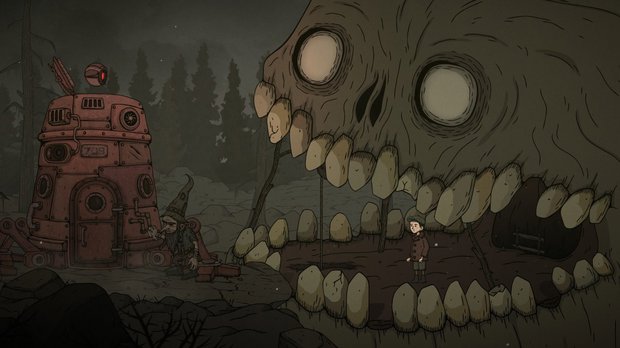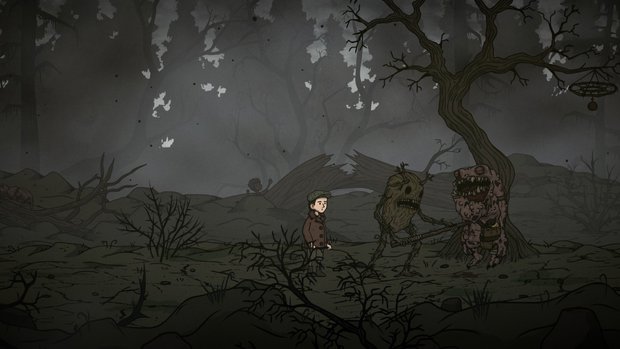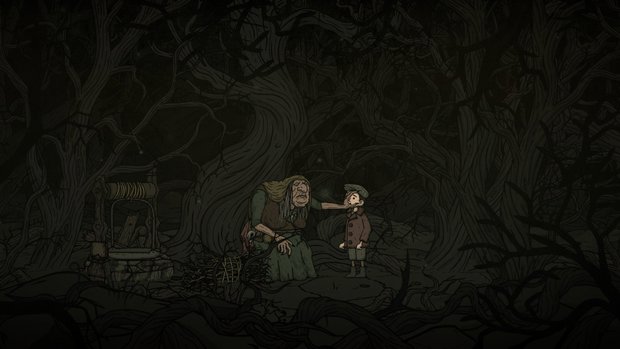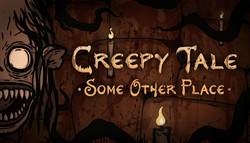Creepy Tale: Some Other Place review

- 0 Comments
Four games in, the hand-drawn dark fantasy puzzle adventure series has arrived right where it belongs
The Creepy Tale series has come a long way in just a few years. The first game was a promising debut from a design standpoint, but it owed such a staggering visual debt to the work of the unaffiliated artist John Kenn Mortensen that it came close to crossing the line between “homage” and “rip-off.” The sequel wisely abandoned that derivative art style in favor of a rounder, more cartoonish approach, but it jettisoned its predecessor’s no-nonsense gameplay in the process. In its place was a messy jumble of obtuse puzzles and infuriating dexterity challenges strung together by plodding expository dialogue, leaving the series’ future shaky at best.
Nevertheless, 2023’s Creepy Tale 3: Ingrid Penance saw developers Creepy Brothers come to better grips with their strengths and weaknesses and settle into a style more aesthetically and philosophically their own. Ingrid immediately distinguished itself from its predecessors with a compelling story and a diverse assortment of creative and interesting puzzles. While visually it seemed reluctant at times to emerge fully from Mortensen’s shadow, it was miles beyond the first entry’s “unlicensed fan-game” approach. Imperfect as it was, it was an important and necessary step in the series’ development, and with its closing credits came the question of whether the developers could maintain their momentum.

Creepy Tale: Some Other Place, the fourth entry, answers that question with an emphatic yes. This is, without doubt, the best Creepy Tale has ever been, and a fulfillment of the potential that’s been evident from the start. There’s still room for improvement, but Some Other Place is as auspicious a development as anyone following this franchise might want.
Martin, the player character, is a young peasant boy who sets out from his family home one morning to do some lakeside fishing. He’s just landed his third fish when a strange hairy creature appears and starts chattering insistently to him. When Martin explains that he can’t understand what it’s saying, the critter responds by stealing his catch and scurrying off into the woods. Martin gives chase, following after the beastie as it plunges through a hole in an old tree…only to emerge in a strange and frightening world totally unlike the one he knows.

This “Other Place,” he soon learns, is a dark and dangerous realm, home to a vast array of fantastical beings. There are gibbering hairball-gremlins like the one who led him there; dwarfish miners toiling within the rocky innards of a petrified giant; lumbering, scarecrow-like leshy; and the hated kvargs, a legion of wicked, tumor-covered toad-things currently marauding across the land and colonizing its other denizens. It turns out the hairy critter lured Martin here for a reason: the kvargs have kidnapped a human princess from Martin’s world, and they’re planning to sacrifice her in a terrible ritual. Martin’s “guide” (who overcomes the language barrier by scratching crude pictures in the dirt) agrees to show him the way home if he’ll help thwart the kvargs’ plot.
Death is a constant presence in the Other Place. Scenes are littered with the corpses of those who couldn’t outrun the kvargs’ war machine, and multiple characters meet grisly on-screen fates. Various dismembered limbs, heads, and digits figure into puzzles, and that’s not even counting the ones scattered around as background details. The color palette is grim and dreary, full of browns, grays, and muted greens; bright colors are rare, save for the pink of the kvargs’ inflamed flesh and the reds of blood and fire. There is little hope here: this is death’s country, and you feel it on every screen. In gameplay terms, dying is just a temporary setback that warps you back to right before you were killed, but the oppressive atmosphere and Martin’s reactions to it make the threat feel real and ever-present nonetheless.

The hand-drawn graphic style lets the game nimbly walk the line between atmospheric and oppressive. It never shies away from horror, but it’s all just cartoonish enough that it doesn’t tilt over from creepy into repulsive. The kvargs are hideous, to be sure, and the rock trolls that sometimes block Martin’s way will smash him as soon as look at him, but their features have a round, balloonish character that keeps them feeling more like storybook monsters than anything you’ll lose sleep over. Locales are richly detailed, with foregrounds framed by piles of forest litter (or grisly kvarg detritus) and wide, scrolling screens whose background elements scroll by in parallax. Forest scenes are close and claustrophobic, while the kvargs’ war camp feels vast and sprawling. An energetic soundtrack lends emotion to each area, striking a skillful balance between spooky, tension-ratcheting synth-strings and bouncier, more whimsical tracks when Martin is exploring in relative safety.
Given the series’ checkered visual history, it was critical that this entry establish a firmer, less derivative artistic identity. Though Ingrid Penance tried to blend a macabre, Mortensen-inspired approach with the rounder, friendlier style of the second game, it seemed reluctant to diverge too far from the accepted Mortensen playbook. While it was nothing close to the first game’s borderline appropriation, some blandly derivative monster design left certain sequences feeling safe and predictable. Creepy Tale would have to strike out farther afield from Mortensen’s aesthetic principles if it was going to carve out its own identity.
Thankfully, Some Other Place has done just that. It doesn’t entirely leave Mortensen behind, but what remains has the character of knowing tribute, more a hat tip to the series’ admitted inspiration than an attempt to soak up some of the same sunlight. There’s no denying his influence on the game’s style—several wizened, hollow-eyed beasties call his work unmistakably to mind, and the human children are cut from a clear Mortensenian cloth—but it’s a single swatch on a mood board that draws from a melange of traditions. The cumulative effect is that, for the first time in the series, the aesthetic seems motivated not by a question of “What would (or wouldn’t) someone else do here?” but “What’s the best thing we can do here?”
In that respect, Some Other Place represents a catching-up of sorts with the rest of the Creepy Brothers’ design ethos. Unique, original, and complex puzzle design has long been the series’ strong suit (chunks of the second game notwithstanding). Materially, this fourth game is no exception, with a roughly three-hour runtime packed full of well-designed, challenging puzzles that reward close attention to your environment. A number of these center on a magic ring that lets Martin stop or speed up time in his immediate vicinity, which forces you to think not only about what’s at hand but about what different circumstances might allow it to become.

Speeding up time might cause a seed to blossom, for instance; temporarily stopping time for a hostile creature can give you a chance to rearrange the environment to your favor. You’ll often have to juggle multiple plates in these sequences, stopping one moving part while accelerating another to try to get everything where you need it. There are also traditional inventory puzzles and combination locks to solve, along with a light and forgiving QTE-like mechanic that crops up when Martin swings a pick or casts his fishing line. (Not to mention an extremely memorable sequence when an old witch asks for a foot massage.) It’s only in a late-game arcade battle against a hellish monster that the game seems to bite off more than it can chew—but if it’s too much trouble, you can skip it entirely.
Mechanically excellent as they are, the puzzles come with some narrative disconnect: there’s almost always enough on-screen for players to figure out what to do, but the why isn’t as clear. From a gameplay perspective, it’s easy to deduce that solving a given puzzle will let you progress further, but within the story, there’s no reason Martin would know that. Why, for instance, would he think to mess around with the machines in a dwarf mine when the locked door he’s trying to get through is up aboveground? How, since nobody’s told him about it, would he know that the next step on his journey requires corralling three singing, disembodied heads into a stone chamber? As players we know why we’re doing it—we’re here to solve puzzles, and this one’s in front of us—but in a character-driven story there should be more driving the protagonist from scene to scene than “knowing where the hotspots are.”

Other than that, Martin is a refreshing fantasy protagonist. He isn’t a secret “chosen one,” or the unsuspecting inheritor of great power; he just happened to be the first person the hair-critter found when going for help. He has the demeanor of an average kid who’d much rather be safe at home, and he never becomes inured to the Other Place’s many horrors. This lends them potency, making it harder for the player to take the dark fantasia of it all for granted. Even when he acquires his enchanted time ring, Martin remains acutely aware of his own vulnerability and the danger all around him.
The voice cast is serviceable but unremarkable, a step down after the wonderful voice work in Ingrid Penance. As in previous games, characters speak with heavy Slavic accents; they’re eminently understandable, but some mistakes in delivery point toward English being neither the actors’ nor the voice director’s first language (i.e. saying “lightning” instead of “lighting.”) That said, most denizens of the Other Place are fantastical creatures who speak their own strange tongues, so the intelligible dialogue is outpaced by various hootings, gruntings and slaverings.
By now Creepy Tale has established itself as a basically episodic series, with entries linked more by shared vibes and values than by characters or timelines. If you’ve never played the other games you’ll have no trouble getting into Some Other Place, but those who have will find many subtle nods to what’s come before, with some even fleshing out the connective tissue between all four entries. One of these is a rather brilliant subversion of a story beat from the second and third games, lasting just long enough to make you think you’ve caught on before juking off in a totally different direction. Series veterans will enjoy the fakeout, while first-time players can simply take it at face value.
Final Verdict
After four entries, the Creepy Tale series is on its most solid footing ever. The developers have figured out what they’re good at, but have also made strides to address and learn from past weaknesses. The puzzles are fun and creative, the setting is delightfully macabre as ever, and the nagging feeling that the art was trying to live up to somebody else’s standard has largely been addressed. There are still some bumps in the road, but Some Other Place leaves me more convinced than ever that these games’ best days lie ahead.
Hot take
Though not without its rough edges, Creepy Tale: Some Other Place is a series high point that moves beyond previous entries’ shortcomings with well-designed puzzles, a wickedly spooky atmosphere, and a more confident, less derivative art style.
Pros
- Dark fairy tale setting and eerie atmosphere are the series’ best yet
- Excellent puzzle design, with plenty of variety and a clever time-manipulation mechanic
- Makes player death feel like a real threat without sacrificing ease of playability
- References to previous games will please seasoned players without alienating newcomers
Cons
- Puzzles often feel disconnected from the story, despite being fun to solve
- Voice acting is serviceable, but with some mistakes that will stand out to fluent English speakers
- Climactic arcade-combat sequence feels clunky and out of place (though it is skippable)
Will played Creepy Tale: Some Other Place on PC using a review code provided by the game's publisher.











0 Comments
Want to join the discussion? Leave a comment as guest, sign in or register.
Leave a comment